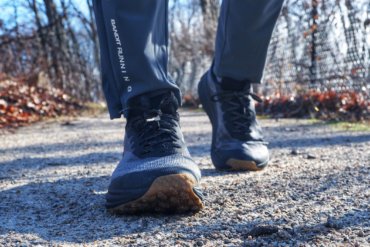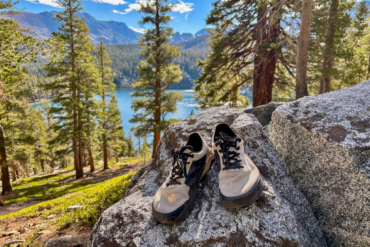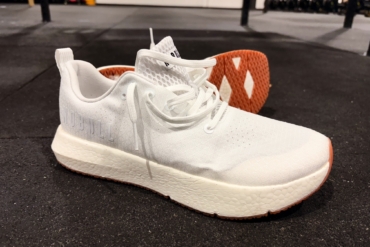Ultrarunning shoes need to be supportive and tough, yet forgiving and comfortable. Here are the best designs according to long-distance mountain runners.
Among outdoor accessories, trail running footwear is a relatively simple tool. On the other hand, designs that fit well and endure hundreds of rugged miles can be hard to narrow down. From rocks to roots and river crossings to scrambles, trail runners venture on much more than soft earth. Furthermore, finding the ideal match for each runner’s unique feet is a personal journey.
To help jump-start the process, we reached out to a handful of the most determined ultrarunners in the field to harness the best bets. Here is a list of the best ultrarunning shoes according to ultramarathoners who venture through terrain around the globe.
Ultrarunning Shoes: Top Picks From the Pros
Altra Lone Peak 4.5: $120
Noe Castañón Mendez ran his first ultra-distance race in 2006 and was immediately hooked. The 49-year-old’s favorite event is the 209-mile Tor des Géants, in Aosta Valley, Italy. To date, the Californian has run close to 90 ultras around the globe. He trains year-round and keeps five pairs of trail running shoes, which each last more than a year.
Mendez has used a range of trail running footwear, including iterations of the HOKA ONE ONE Challenger ATR 5 ($130), as well as various models from Fila and The North Face.
If Mendez had to select one pair, it’s the Altra Lone Peak 4.5. “I choose my footwear based on the terrain that I’m running in. I love cushion, and I train for miles and miles on mostly technical terrain,” said Mendez. He replaces his shoes based on how worn-out they look, including the tread, cushion, and upper.
The Altra Lone Peak 4.5 has worked well in mountainous, technical, and hilly terrain with variable conditions — including a lot of mud. Occasionally, he’ll take these shoes on asphalt and flat terrain, too.
The Lone Peak 4.5 features a moderate amount of cushion. The upper is made of mesh that’s durable and airy. The shoe’s stack height is 25 mm off the ground across the entire foot. The lugs are canted for solid traction.
The midsole is a dual layer of foam that offers more stability than former iterations of this shoe. And the outsole’s rubber is designed to be durable with a dependable bite across various terrain.
“These shoes provide good grip and cushioning. They also handle all conditions well. Some runners have wide feet or they pronate a lot. I don’t have that problem, so I don’t have brand alliance for that particular reason, but this shoe could help some folks with those issues,” he said.
Mendez doesn’t track mileage but usually runs every day of the week. His 2020 race lineup, for example, included the HURT 100-Mile Endurance Run, the Barkley Marathons, the Travesía en las Sierras 100-Mile, the Ehunmilak Ultra Trail 104-mile, and the Wasatch Front 100 Mile Endurance Run.
If a pair of shoes survives any of the aforementioned events, it’s a top choice in our book.
Note: The women’s version 4.5 is currently sold out, but we’ve linked to the newer version 5 below
Topo Athletic Ultraventure: $98-130
Amanda Simpson, 48, is an extremely passionate ultrarunner and trail footwear aficionado. The marketing executive lives in Golden, Colorado. She’s completed nearly 30 ultra-distance events in 8 years. And she finished as the eighth woman overall at the Ute 100 Mile Trail Race.
During the winter season, she skis. So, she focuses on trail running from March through October. Typically, she rotates through five different pairs at a time and goes through seven pairs per season.
“I like to swap out my trail running shoes based on the terrain, my mood, and my level of fatigue — in other words, I have some serious slog shoes. I also like to rotate shoes during long races. I’ll stash a completely different pair of shoes in my drop bag in case I get blisters and need a different fit.
“Since I get massive foot swell during long races, I keep the shoes with wider toe boxes for the second half. Even if I don’t need a change, it can be a big mental boost to have fresh feet,” explained Simpson.
Simpson stands by more than a dozen different shoes that work well for certain routes, races, and days. That list includes a wide range of styles from the Saucony Peregrine 10 ($120) and La Sportiva Jackal ($140) to the HOKA ONE ONE Speedgoat 4 ($145) or Altra Timp 2 ($140).
However, Simpson’s favorite trail running shoe is hands down the Topo Athletic Ultraventure. “The Ultraventure has a wide toe box but a snug midfoot fit. It has an incredible amount of cushion but at a 30/25mm stack height, you don’t feel like you’re running on a platform. And you don’t get the heel roll that can occur in other highly cushioned shoes.
“It doesn’t have a rock plate, so it remains super flexible. And the Vibram outsole is always a plus. I also like the level of arch support. It’s the absolute perfect shoe — and it works on pretty much any terrain, in any condition,” she explained.
The Ultraventure features a multidensity foam midsole with a softer heel and firmer medial support. For comfort, the shoe includes an OrthoLite foam footbed. The shoe’s lugs are well spaced to allow for mud and snow release.
The upper is made of reinforced mesh that’s breathable yet abrasion-resistant. The design also includes a streamlined vent — shaped like fish gills — that allows for water drainage and ventilation, above the outsole.
Simpson used these ultrarunning shoes on packed dirt and technical trails, including Rocky Mountain scree and boulder fields. She also runs in the Moab area, where the trails range from sand to cement-hard slickrock.
The downside? “I feel like these shoes lose their luster around 280 miles and usually swap out somewhere over the 300-mile mark. They are slightly cheaper than other shoes, but I would love it if the support felt fresh a bit longer,” Simpson said. “If you love a luxurious feel but demand something technical, these are the shoes for you.”
Altra Olympus 3.5 – Women’s: $100 (33% Off)
Ultrarunner Junko Kazukawa is a personal trainer and endurance coach in Denver, Colorado. To date, she’s completed 19 100-mile races. The 56-year-old was also the first person to complete the Leadville Race Series — including two ultra-distance events — and the Grand Slam of Ultrarunning in one season. (Her Ultrarunning Grand Slam included back-to-back completion of the Wasatch Front 100 Mile, Vermont 100 Endurance Race, Western States 100-Mile Endurance Run, and Leadville Trail 100 Run.)
Kazukawa trains year-round. She typically rotates through four pairs of trail running shoes each year. Over the years, her trail running footwear has included iterations of the New Balance Fresh Foam 1080 ($150), La Sportiva Akasha ($140), HOKA ONE ONE Stinson ATR Trail Running Shoe ($160), and Altra Lone Peak 4 Low RSM ($150).
The listed shoes are all well-constructed. However, her number-one choice for ultrarunning shoes is the Altra Olympus 3.5.
“These shoes have a wide toe box, which is great, since I have wide feet. This gives me enough space to move my toes. Also, my feet get swollen during long-distance races, so I need the extra room,” Kazukawa explained.
In addition to the Olympus 3.5’s wide silhouette, the upper was updated to be more durable than previous models. The shoe has balanced cushioning, so the heel and forefoot are the same distance from the ground.
The midsole is flexible and responsive, and the outsole features Vibram Megagrip rubber. The tread’s proprietary pattern provides traction on a variety of surfaces and stability on uneven terrain.
“This shoe has great cushion for long-distance races and runs, which also offers great support on uneven rocks. And, the Vibram outsole is sturdy and grippy on terrain features,” she said. For more than 300 miles, Kazukawa has used these shoes to train on various terrain from mountainous, gnarly routes to sandstone, flat, and smooth trails.
Overall, the shoes are durable. However, she noted visible wear and tear on the interior upper and the heels, which “are made out of soft material and get worn down easily,” she said.
Ultimately, this shoe is a good match for people who need a wide toe box, run long distances, or like more cushion.
Shop NowAltra Olympus – Men’s: $150
Utahan Jim Skaggs has crossed the finish line of nearly 30 100-mile races, including 10 Wasatch Front 100 Mile Endurance Runs. The trail race director started ultrarunning in 1993. The 61-year-old typically backs off of trail running from November to February each year. Each season, Skaggs goes through two sets of trail running shoes (without rotating the pairs) and one road running shoe.
For the past 6 years, his go-to ultrarunning shoe has been the Altra Olympus. “The shoe has plenty of cushion and a wide toe box. And I’ve never gotten a blister as a result of wearing them during a race. And the shoes are pretty grippy in virtually all conditions from rainy to arid,” said Skaggs.
The Olympus offers a high amount of cushion. The shoe’s stack height is 33 mm, and the heel and forefoot are the same distance off the ground. The midsole is flexible but responsive.
On the upper, a streamlined built-in Velcro tab enables a strapless gaiter attachment. And the upper is more durable than in earlier designs.
“I’ve not had anything happen to the upper in terms of wear and tear. On the soles, it’s the typical tread wear that happens from the number of miles adding up,” he said. The design works well for mountainous terrain such as the Wasatch Range, where it’s rocky, steep, and dusty in the summer. He has tallied nearly 650 miles on each set he’s owned.
“I recommend this shoe to just about anyone, but specifically for someone who needs or wants max cushion and great tread,” he said.
Shop NowRunning Shoe FAQ
Break through the overwhelming number of ultrarunning shoe options and get some guidance with the answers to frequently asked questions.
How Should Trail Running Shoes Fit?
Stack and Drop
Unless you’re running barefoot, every shoe has a stack. Measured in millimeters, the stack refers to how high the insole sits off the ground. Shoes with more cushion inherently have a higher stack. Furthermore, most shoes have a “drop” in stack height from the heel to the toe.
If you’re new to running, experts recommend a lower heel drop; it builds a wider range of motion and strength, which makes you a healthier runner.
Cushion
Stepping into a high-cushion trail shoe can feel like walking on a cloud. Those running longer distances (or who supinate) will prefer more cushion to dampen the repetitive pounding and provide support. But it can become a penalty. Extra foam adds extra weight.
So, is more cushion better? Not always. It’s about finding the right balance between speed and comfort. If you’re aiming for a new PR, look for a light, stiffer shoe with a harder cushion and minimal lug friction.
Flexibility
Flexibility is your friend on the trails. You need variability to match the variable terrain. Trail runners will prefer a shoe with a firm outsole and less cushion but a firm toebox to push off of. Flexibility and torsion can help the foot adapt to the trail and prevent injuries.
For more help choosing, check out the complete guide to choosing a trail running shoe.
How Long Do Running Shoes Last?
So if you run 10 miles per week, your shoes could last 8 months to a year. If you’re logging 20 miles per week, plan on replacing your running shoes every 4 to 6 months.
And if you see excessive wear patterns, holes, tears, or notice a decrease in footbed comfort, it’s probably time to grab a new pair of sneakers.














